סכימת DSPL
קל לארגן דפים בעזרת אוספים
אפשר לשמור ולסווג תוכן על סמך ההעדפות שלך.
בדף הזה ובדפי המשנה המקושרים אליו מתועדים סכימת ה-XML של DSPL.
התוכן הזה מיועד למשתמשים מתקדמים שרוצים להבין
הפרטים הכלליים של השפה; לרוב המשתמשים, התוכן
ב
המדריך למפתחים צריך להיות מספיק כדי ליצור ולערוך
מערכי נתונים של DSPL.
סכימת ה-XML המלאה זמינה להורדה בפורמט XSD
ב
אתר לקוד DSPL.
רכיב: dspl
| מרחב שמות |
http://schemas.google.com/dspl/2010 |
| הערות |
מפרט DSPL מתאר מערך נתונים. מערך נתונים הוא
מזוהה באמצעות מרחב השמות שלו. מערך נתונים מורכב
רכיבים: - טבלאות: נתונים עבור המושגים והפלחים שהוגדרו
מערך נתונים - מושגים: הגדרות ומבנים שנבחרו על ידי המשתמש, שנעשה בהם שימוש
מערך נתונים - פרוסות: שילובים של מאפיינים ומדדים שקיימים
מערך נתונים - Topics: תוויות היררכיות שמשמשות לארגון המושגים של
מערך הנתונים |
| תרשים |
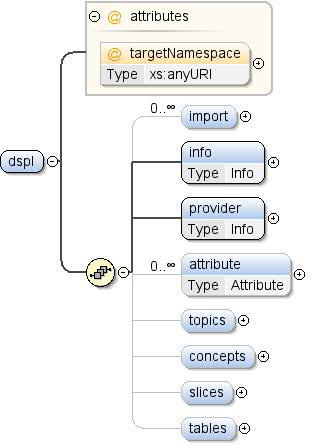 |
| מאפיינים |
|
| דגם |
Import* , info , provider ,
מאפיין* , נושאים{0,1} , מושגים{0,1} , פרוסות{0,1} , טבלאות{0,1} |
| ילדים |
attribute, Concepts, ייבוא,
מידע, ספק, פרוסות,
טבלאות, נושאים |
| Instance |
<dspl targetNamespace="">
<import location="" namespace="">{0,unbounded}</import>
<info>{1,1}</info>
<provider>{1,1}</provider>
<attribute concept="" id="">{0,unbounded}</attribute>
<topics>{0,1}</topics>
<concepts>{0,1}</concepts>
<slices>{0,1}</slices>
<tables>{0,1}</tables>
</dspl>
|
| מאפיינים |
| QName |
סוג |
קבוע |
ברירת מחדל |
שימוש |
הערה |
| targetNamespace |
xs:anyURI |
|
|
אופציונלי |
כל מערך נתונים יכול לספק מרחב שמות יעד. היעד
מרחב שמות הוא URI שמזהה באופן ייחודי את מערך הנתונים. לקבלת מידע נוסף
מידע על השימוש במרחבי שמות ב-XML זמין במאמרים הבאים:
http://www.w3.org/TR/REC-xml-names/ אם לא קיים מרחב יעד
אז ייווצר מרחב שמות כשמערך הנתונים
שיובאו. |
|
| מקור |
<xs:element name="dspl">
<xs:annotation>
<xs:documentation>A DSPL specification describes a dataset. A dataset is
identified by its namespace. A dataset is comprised of the
following elements:
- Tables: Data for the concepts and slices defined in the
dataset
- Concepts: User-specified definitions and structures used in
the dataset
- Slices: Combinations of dimensions and metrics present in
the dataset
- Topics: Hierarchical labels used to organise the concepts of
the dataset</xs:documentation>
</xs:annotation>
<xs:complexType>
<xs:sequence>
<xs:element name="import" minOccurs="0" maxOccurs="unbounded">
<xs:annotation>
<xs:documentation>Import directive for external datasets -- modeled after
the XML Schema import directive. In order to use
elements defined in an external dataset, the external
dataset must be referenced using an import directive.</xs:documentation>
</xs:annotation>
<xs:complexType>
<xs:attribute name="namespace" use="required">
<xs:annotation>
<xs:documentation>The namespace of the imported dataset, specified as
a URI. A prefix must be associated with this
namespace before its contents can be referenced. See
[XML Namespaces] for more information about the use
of namespaces and prefixes in XML.</xs:documentation>
</xs:annotation>
</xs:attribute>
<xs:attribute name="location" use="optional">
<xs:annotation>
<xs:documentation>An optional location where the definition of the
imported dataset can be found, specified as a
URL. If the location is omitted, the system
processing this DSPL dataset must already know the
imported dataset.
Implementation note: The Google dataset importer
ignores the location attribute. Any imported dataset
must be known by the Google importer beforehand.</xs:documentation>
</xs:annotation>
</xs:attribute>
</xs:complexType>
</xs:element>
<xs:element name="info" type="Info" minOccurs="1">
<xs:annotation>
<xs:documentation>General information about the dataset.</xs:documentation>
</xs:annotation>
</xs:element>
<xs:element name="provider" type="Info">
<xs:annotation>
<xs:documentation>General information about the dataset provider.</xs:documentation>
</xs:annotation>
</xs:element>
<xs:element name="attribute" type="Attribute" minOccurs="0" maxOccurs="unbounded">
<xs:annotation>
<xs:documentation>Attribute associated with the dataset.</xs:documentation>
</xs:annotation>
</xs:element>
<xs:element name="topics" minOccurs="0">
<xs:annotation>
<xs:documentation>A hierarchy of topics used to organize the contents of
the dataset. The order in which topics are given is
meaningful and should be respected by visualizations
that displays these topics.</xs:documentation>
</xs:annotation>
<xs:complexType>
<xs:sequence>
<xs:element name="topic" type="Topic" maxOccurs="unbounded"/>
</xs:sequence>
</xs:complexType>
</xs:element>
<xs:element name="concepts" minOccurs="0">
<xs:annotation>
<xs:documentation>A list of concepts defined in this dataset.</xs:documentation>
</xs:annotation>
<xs:complexType>
<xs:sequence>
<xs:element name="concept" type="Concept" maxOccurs="unbounded"/>
</xs:sequence>
</xs:complexType>
</xs:element>
<xs:element name="slices" minOccurs="0">
<xs:annotation>
<xs:documentation>A list of slices defined in this dataset.</xs:documentation>
</xs:annotation>
<xs:complexType>
<xs:sequence>
<xs:element name="slice" type="Slice" maxOccurs="unbounded"/>
</xs:sequence>
</xs:complexType>
</xs:element>
<xs:element name="tables" minOccurs="0">
<xs:annotation>
<xs:documentation>A list of tables defined in this dataset.</xs:documentation>
</xs:annotation>
<xs:complexType>
<xs:sequence>
<xs:element name="table" type="Table" maxOccurs="unbounded"/>
</xs:sequence>
</xs:complexType>
</xs:element>
</xs:sequence>
<xs:attribute name="targetNamespace" type="xs:anyURI" use="optional">
<xs:annotation>
<xs:documentation>Each dataset may provide a target namespace. The
target namespace is a URI that uniquely identifies the
dataset. For more information about the use of namespaces in XML,
see:
http://www.w3.org/TR/REC-xml-names/
If no targetNamespace is provided, then a namespace will be
generated when the dataset is imported.</xs:documentation>
</xs:annotation>
</xs:attribute>
</xs:complexType>
</xs:element>
|
רכיב: dspl / ייבוא
| מרחב שמות |
http://schemas.google.com/dspl/2010 |
| הערות |
הוראת ייבוא למערכי נתונים חיצוניים – מודל לאחר ה-XML
הוראה לייבוא סכימה. כדי להשתמש ברכיבים שמוגדרים בקובץ
של מערך הנתונים, יש להפנות למערך הנתונים החיצוני באמצעות ייבוא
. |
| תרשים |
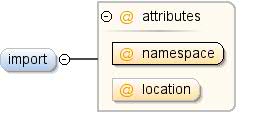 |
| מאפיינים |
| content: |
מורכב |
| minOccurs: |
0 |
| maxOccurs: |
ללא גבולות |
|
| מאפיינים |
| QName |
סוג |
קבוע |
ברירת מחדל |
שימוש |
הערה |
| מיקום |
|
|
|
אופציונלי |
מיקום אופציונלי שבו ההגדרה של
את מערך הנתונים, לציין אותו ככתובת URL. אם המיקום הוא
שהושמט, המערכת שמעבדת את מערך הנתונים של ה-DSPL כבר צריכה לדעת
במערך הנתונים שיובא. הערה על הטמעה: מערך הנתונים של Google
יבואן מתעלם ממאפיין המיקום. בכל מערך נתונים מיובא
יבואן Google ידוע מראש. |
| מרחב שמות |
|
|
|
חובה |
מרחב השמות של מערך הנתונים המיובא, מוגדר בתור
URI. צריך לשייך קידומת למרחב השמות הזה לפני
ניתן להפנות לתוכן. מידע נוסף זמין במאמר [מרחבי שמות של XML]
מידע על השימוש במרחבי שמות וקידומות ב-
XML. |
|
| מקור |
<xs:element name="import" minOccurs="0" maxOccurs="unbounded">
<xs:annotation>
<xs:documentation>Import directive for external datasets -- modeled after
the XML Schema import directive. In order to use
elements defined in an external dataset, the external
dataset must be referenced using an import directive.</xs:documentation>
</xs:annotation>
<xs:complexType>
<xs:attribute name="namespace" use="required">
<xs:annotation>
<xs:documentation>The namespace of the imported dataset, specified as
a URI. A prefix must be associated with this
namespace before its contents can be referenced. See
[XML Namespaces] for more information about the use
of namespaces and prefixes in XML.</xs:documentation>
</xs:annotation>
</xs:attribute>
<xs:attribute name="location" use="optional">
<xs:annotation>
<xs:documentation>An optional location where the definition of the
imported dataset can be found, specified as a
URL. If the location is omitted, the system
processing this DSPL dataset must already know the
imported dataset.
Implementation note: The Google dataset importer
ignores the location attribute. Any imported dataset
must be known by the Google importer beforehand.</xs:documentation>
</xs:annotation>
</xs:attribute>
</xs:complexType>
</xs:element>
|
רכיב: dspl / מידע
| מרחב שמות |
http://schemas.google.com/dspl/2010 |
| הערות |
מידע כללי על מערך הנתונים. |
| תרשים |
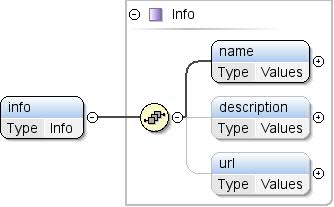 |
| סוג |
מידע |
| מאפיינים |
| content: |
מורכב |
| minOccurs: |
1 |
|
| דגם |
name , description{0,1} , url{0,1} |
| ילדים |
description, name, url |
| Instance |
<info>
<name>{1,1}</name>
<description>{0,1}</description>
<url>{0,1}</url>
</info>
|
| מקור |
<xs:element name="info" type="Info" minOccurs="1">
<xs:annotation>
<xs:documentation>General information about the dataset.</xs:documentation>
</xs:annotation>
</xs:element>
|
רכיב: dspl / ספק
| מרחב שמות |
http://schemas.google.com/dspl/2010 |
| הערות |
מידע כללי על ספק מערך הנתונים. |
| תרשים |
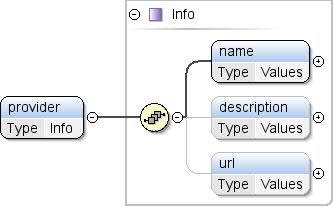 |
| סוג |
מידע |
| מאפיינים |
|
| דגם |
name , description{0,1} , url{0,1} |
| ילדים |
description, name, url |
| Instance |
<provider>
<name>{1,1}</name>
<description>{0,1}</description>
<url>{0,1}</url>
</provider>
|
| מקור |
<xs:element name="provider" type="Info">
<xs:annotation>
<xs:documentation>General information about the dataset provider.</xs:documentation>
</xs:annotation>
</xs:element>
|
רכיב: dspl / מאפיין
| מרחב שמות |
http://schemas.google.com/dspl/2010 |
| הערות |
המאפיין שמשויך למערך הנתונים. |
| תרשים |
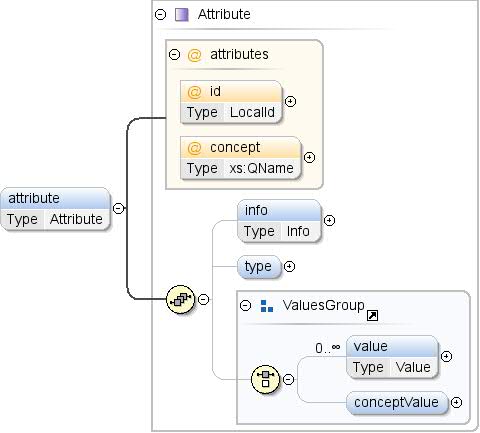 |
| סוג |
מאפיין |
| מאפיינים |
| content: |
מורכב |
| minOccurs: |
0 |
| maxOccurs: |
ללא גבולות |
|
| דגם |
info{0,1} , type{0,1} , (value*
| conceptValue{0,1}) |
| ילדים |
conceptValue, info, type,
ערך |
| Instance |
<attribute concept="" id="">
<info>{0,1}</info>
<type format="" ref="">{0,1}</type>
</attribute>
|
| מאפיינים |
| QName |
סוג |
קבוע |
ברירת מחדל |
שימוש |
הערה |
| קונספט |
xs:QName |
|
|
אופציונלי |
הפניה לקונספט שתואם לערכים
של המאפיין. אם המאפיין מציין סוג, אז הסוג
חייבים להתאים לסוג של הקונספט שאליו הוא מפנה. הפניה אל
מושג חיצוני חייב להיות בצורה
'prefix:other_Concept_id', כאשר 'prefix' תואם לערך
הקידומת שמשמשת למרחב השמות של מערך הנתונים החיצוני (ראו XML
מרחבי שמות). |
| id |
LocalId |
|
|
אופציונלי |
המזהה של מאפיין הקונספט. המזהה הזה חייב להיות
ייחודיות בתפיסה (במאפיינים ובנכסים).
ניתן להשמיט את המזהה אם צוין מאפיין הקונספט. כאן
במקרה, מזהה הוא פשטות שנוצרת עם הערך של השם המקומי של
של המונח שהוזכר. לדוגמה: <attribute
concept="unit:currency"/> זהה ל-
<attribute id="currency"
concept="unit:currency"/> |
|
| מקור |
<xs:element name="attribute" type="Attribute" minOccurs="0" maxOccurs="unbounded">
<xs:annotation>
<xs:documentation>Attribute associated with the dataset.</xs:documentation>
</xs:annotation>
</xs:element>
|
רכיב: dspl / נושאים
| מרחב שמות |
http://schemas.google.com/dspl/2010 |
| הערות |
היררכיה של נושאים שמשמשת לארגון התוכן של
של הכיתובים. הסדר שבו הנושאים מוצגים הוא משמעותי וצריכים להיות
להמחשה באמצעות תצוגות חזותיות שמציגות את הנושאים האלה. |
| תרשים |
 |
| מאפיינים |
| content: |
מורכב |
| minOccurs: |
0 |
|
| דגם |
topic+ |
| ילדים |
נושא |
| Instance |
<topics>
<topic id="" parentTopic="">{1,unbounded}</topic>
</topics>
|
| מקור |
<xs:element name="topics" minOccurs="0">
<xs:annotation>
<xs:documentation>A hierarchy of topics used to organize the contents of
the dataset. The order in which topics are given is
meaningful and should be respected by visualizations
that displays these topics.</xs:documentation>
</xs:annotation>
<xs:complexType>
<xs:sequence>
<xs:element name="topic" type="Topic" maxOccurs="unbounded"/>
</xs:sequence>
</xs:complexType>
</xs:element>
|
| מרחב שמות |
http://schemas.google.com/dspl/2010 |
| תרשים |
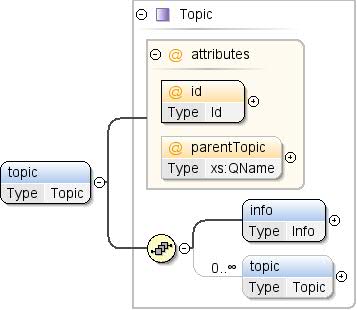 |
| סוג |
נושא |
| מאפיינים |
| content: |
מורכב |
| maxOccurs: |
ללא גבולות |
|
| דגם |
info , נושא* |
| ילדים |
info, topic |
| Instance |
<topic id="" parentTopic="">
<info>{1,1}</info>
<topic id="" parentTopic="">{0,unbounded}</topic>
</topic>
|
| מאפיינים |
| QName |
סוג |
קבוע |
ברירת מחדל |
שימוש |
הערה |
| id |
מזהה |
|
|
חובה |
המזהה הייחודי של הנושא
של הכיתובים. |
| parentTopic |
xs:QName |
|
|
אופציונלי |
המזהה של נושא ההורה של הנושא הזה, אם יש לו כזה.
לא ניתן לציין נושא הורה לנושאים שמוצגים בתוך
נושאים אחרים. |
|
| מקור |
<xs:element name="topic" type="Topic" maxOccurs="unbounded"/>
|
רכיב: dspl / מושגים
| מרחב שמות |
http://schemas.google.com/dspl/2010 |
| הערות |
רשימת המושגים שהוגדרו במערך הנתונים הזה. |
| תרשים |
 |
| מאפיינים |
| content: |
מורכב |
| minOccurs: |
0 |
|
| דגם |
Concept+ |
| ילדים |
קונספט |
| Instance |
<concepts>
<concept extends="" id="">{1,unbounded}</concept>
</concepts>
|
| מקור |
<xs:element name="concepts" minOccurs="0">
<xs:annotation>
<xs:documentation>A list of concepts defined in this dataset.</xs:documentation>
</xs:annotation>
<xs:complexType>
<xs:sequence>
<xs:element name="concept" type="Concept" maxOccurs="unbounded"/>
</xs:sequence>
</xs:complexType>
</xs:element>
|
| מרחב שמות |
http://schemas.google.com/dspl/2010 |
| תרשים |
 |
| סוג |
קונספט |
| מאפיינים |
| content: |
מורכב |
| maxOccurs: |
ללא גבולות |
|
| דגם |
info , topic* , type{0,1} ,
attribute* , property* , defaultValue{0,1} , table{0,1} |
| ילדים |
attribute, defaultValue, info,
property, table, topic,
סוג |
| Instance |
<concept extends="" id="">
<info>{1,1}</info>
<topic ref="">{0,unbounded}</topic>
<type ref="">{0,1}</type>
<attribute concept="" id="">{0,unbounded}</attribute>
<property concept="" id="" isMapping="false" isParent="false">{0,unbounded}</property>
<defaultValue>{0,1}</defaultValue>
<table ref="">{0,1}</table>
</concept>
|
| מאפיינים |
| QName |
סוג |
קבוע |
ברירת מחדל |
שימוש |
הערה |
| extends |
xs:QName |
|
|
אופציונלי |
המזהה הייחודי של קונספט מסוים
נמשך. אפשר להגדיר את המושג שאליו קיימת הפניה באותו מערך נתונים
או מערך נתונים אחר, כלומר במערך נתונים אחר. הפניה אל
המושג חייב להיות בפורמט "prefix:other_Concept_id",
כאשר 'prefix' היא הקידומת שמשמשת למרחב השמות של
במערך הנתונים החיצוני (ראו מרחבי שמות של XML). |
| id |
מזהה |
|
|
חובה |
המזהה הייחודי של הקונספט, שצריך להיות
ייחודיים במערך הנתונים. |
|
| מקור |
<xs:element name="concept" type="Concept" maxOccurs="unbounded"/>
|
רכיב: dspl / פרוסות
| מרחב שמות |
http://schemas.google.com/dspl/2010 |
| הערות |
רשימת הפרוסות שמוגדרות במערך הנתונים הזה. |
| תרשים |
 |
| מאפיינים |
| content: |
מורכב |
| minOccurs: |
0 |
|
| דגם |
slice+ |
| ילדים |
slice (פרוסה) |
| Instance |
<slices>
<slice id="">{1,unbounded}</slice>
</slices>
|
| מקור |
<xs:element name="slices" minOccurs="0">
<xs:annotation>
<xs:documentation>A list of slices defined in this dataset.</xs:documentation>
</xs:annotation>
<xs:complexType>
<xs:sequence>
<xs:element name="slice" type="Slice" maxOccurs="unbounded"/>
</xs:sequence>
</xs:complexType>
</xs:element>
|
| מרחב שמות |
http://schemas.google.com/dspl/2010 |
| תרשים |
 |
| סוג |
פרוסה |
| מאפיינים |
| content: |
מורכב |
| maxOccurs: |
ללא גבולות |
|
| דגם |
info{0,1} , מאפיין+ , מדד+
, טבלה |
| ילדים |
מאפיין, מידע, מדד,
טבלה |
| Instance |
<slice id="">
<info>{0,1}</info>
<dimension concept="">{1,unbounded}</dimension>
<metric concept="">{1,unbounded}</metric>
<table ref="">{1,1}</table>
</slice>
|
| מאפיינים |
| QName |
סוג |
קבוע |
ברירת מחדל |
שימוש |
הערה |
| id |
מזהה |
|
|
חובה |
המזהה הייחודי של הפלח. |
|
| מקור |
<xs:element name="slice" type="Slice" maxOccurs="unbounded"/>
|
רכיב: dspl / טבלאות
| מרחב שמות |
http://schemas.google.com/dspl/2010 |
| הערות |
רשימת הטבלאות שהוגדרו במערך הנתונים הזה. |
| תרשים |
 |
| מאפיינים |
| content: |
מורכב |
| minOccurs: |
0 |
|
| דגם |
table+ |
| ילדים |
טבלה |
| Instance |
<tables>
<table id="">{1,unbounded}</table>
</tables>
|
| מקור |
<xs:element name="tables" minOccurs="0">
<xs:annotation>
<xs:documentation>A list of tables defined in this dataset.</xs:documentation>
</xs:annotation>
<xs:complexType>
<xs:sequence>
<xs:element name="table" type="Table" maxOccurs="unbounded"/>
</xs:sequence>
</xs:complexType>
</xs:element>
|
| מרחב שמות |
http://schemas.google.com/dspl/2010 |
| תרשים |
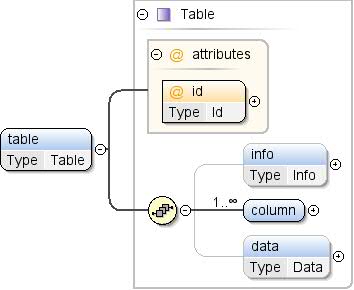 |
| סוג |
טבלה |
| מאפיינים |
| content: |
מורכב |
| maxOccurs: |
ללא גבולות |
|
| דגם |
info{0,1} , עמודה+ , data{0,1} |
| ילדים |
column, data, info |
| Instance |
<table id="">
<info>{0,1}</info>
<column format="" id="" type="">{1,unbounded}</column>
<data>{0,1}</data>
</table>
|
| מאפיינים |
| QName |
סוג |
קבוע |
ברירת מחדל |
שימוש |
הערה |
| id |
מזהה |
|
|
חובה |
המזהה הייחודי של הטבלה בשדה
של הכיתובים. |
|
| מקור |
<xs:element name="table" type="Table" maxOccurs="unbounded"/>
|
מאפיין: dspl / ייבוא / @namespace
| מרחב שמות |
אין מרחב שמות |
| הערות |
מרחב השמות של מערך הנתונים המיובא, שצוין כ-URI. א'
צריך לשייך את קידומת למרחב השמות הזה כדי שהתוכן שלה
שיש הפניה אליו. למידע נוסף לגבי השימוש ב[מרחבי שמות של XML], ראו [מרחבי שמות של XML]
מרחבי שמות וקידומות ב-XML. |
| מאפיינים |
|
| בשימוש על ידי |
|
| מקור |
<xs:attribute name="namespace" use="required">
<xs:annotation>
<xs:documentation>The namespace of the imported dataset, specified as
a URI. A prefix must be associated with this
namespace before its contents can be referenced. See
[XML Namespaces] for more information about the use
of namespaces and prefixes in XML.</xs:documentation>
</xs:annotation>
</xs:attribute>
|
מאפיין: dspl / ייבוא / @location
| מרחב שמות |
אין מרחב שמות |
| הערות |
מיקום אופציונלי שבו ההגדרה של
את מערך הנתונים, לציין אותו ככתובת URL. אם המיקום יושמט,
שמעבדת את מערך הנתונים של ה-DSPL, צריכה כבר לדעת
של הכיתובים. הערה לגבי הטמעה: יבואן מערך הנתונים של Google מתעלם
מאפיין המיקום. כל מערך נתונים מיובא צריך להיות ידוע ל-Google
לייבוא מראש. |
| מאפיינים |
|
| בשימוש על ידי |
|
| מקור |
<xs:attribute name="location" use="optional">
<xs:annotation>
<xs:documentation>An optional location where the definition of the
imported dataset can be found, specified as a
URL. If the location is omitted, the system
processing this DSPL dataset must already know the
imported dataset.
Implementation note: The Google dataset importer
ignores the location attribute. Any imported dataset
must be known by the Google importer beforehand.</xs:documentation>
</xs:annotation>
</xs:attribute>
|
מאפיין: dspl / @targetNamespace
| מרחב שמות |
אין מרחב שמות |
| הערות |
כל מערך נתונים יכול לספק מרחב שמות יעד. היעד
מרחב שמות הוא URI שמזהה באופן ייחודי את מערך הנתונים. לקבלת מידע נוסף
מידע על השימוש במרחבי שמות ב-XML זמין במאמרים הבאים:
http://www.w3.org/TR/REC-xml-names/ אם לא צוין מרחב יעד,
כשמערך הנתונים יופק, המערכת תיצור מרחב שמות
שיובאו. |
| סוג |
xs:anyURI |
| מאפיינים |
|
| בשימוש על ידי |
|
| מקור |
<xs:attribute name="targetNamespace" type="xs:anyURI" use="optional">
<xs:annotation>
<xs:documentation>Each dataset may provide a target namespace. The
target namespace is a URI that uniquely identifies the
dataset. For more information about the use of namespaces in XML,
see:
http://www.w3.org/TR/REC-xml-names/
If no targetNamespace is provided, then a namespace will be
generated when the dataset is imported.</xs:documentation>
</xs:annotation>
</xs:attribute>
|
נוצר באמצעות
oXygen XML Editor
אלא אם צוין אחרת, התוכן של דף זה הוא ברישיון Creative Commons Attribution 4.0 ודוגמאות הקוד הן ברישיון Apache 2.0. לפרטים, ניתן לעיין במדיניות האתר Google Developers. Java הוא סימן מסחרי רשום של חברת Oracle ו/או של השותפים העצמאיים שלה.
עדכון אחרון: 2025-07-25 (שעון UTC).
[[["התוכן קל להבנה","easyToUnderstand","thumb-up"],["התוכן עזר לי לפתור בעיה","solvedMyProblem","thumb-up"],["סיבה אחרת","otherUp","thumb-up"]],[["חסרים לי מידע או פרטים","missingTheInformationINeed","thumb-down"],["התוכן מורכב מדי או עם יותר מדי שלבים","tooComplicatedTooManySteps","thumb-down"],["התוכן לא עדכני","outOfDate","thumb-down"],["בעיה בתרגום","translationIssue","thumb-down"],["בעיה בדוגמאות/בקוד","samplesCodeIssue","thumb-down"],["סיבה אחרת","otherDown","thumb-down"]],["עדכון אחרון: 2025-07-25 (שעון UTC)."],[],["The DSPL XML schema defines a dataset's structure using key components: `tables`, `concepts`, `slices`, and `topics`. The root `dspl` element encapsulates the dataset, utilizing `import` to reference externals, `info` and `provider` for metadata, `attribute` for dataset attributes, and `topics` to hierarchically organize the concepts. `concepts`, `slices`, `tables` are for concept definition, slice definition, and data table, respectively. Each element like `import`, `info`, `provider`, `attribute`, `topic`, `concept`, `slice`, `table` uses specific attributes and child elements for configuration. Each element has a specific cardinality that is defined in the document.\n"]]













